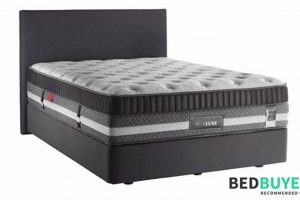Selecting a sleeping surface that alleviates discomfort in the upper torso is crucial for individuals experiencing pain localized in the shoulder region. This type of mattress aims to minimize pressure points and promote proper spinal alignment, factors often implicated in exacerbating shoulder-related pain. As an example, a mattress with enhanced contouring capabilities can adapt to the sleeper’s body, reducing stress on the affected joint.
The importance of selecting a mattress designed to address shoulder pain extends beyond immediate comfort. It contributes to improved sleep quality, which, in turn, supports overall physical and mental well-being. Historically, individuals relied on rudimentary bedding materials; however, advancements in materials science and sleep technology have led to the development of specialized mattresses capable of providing targeted support and pressure relief. The benefits include reduced pain, improved sleep posture, and potentially mitigating the need for frequent pain medication.
The subsequent sections will delve into the specific mattress types, materials, and features to consider when selecting a suitable sleeping surface. Considerations will include factors such as firmness levels, construction, and the importance of aligning mattress choice with individual sleep preferences and physical characteristics.
Mattress Selection Strategies for Shoulder Pain Mitigation
The following guidelines offer strategic considerations for selecting a mattress designed to alleviate shoulder pain and promote restorative sleep.
Tip 1: Prioritize Pressure Relief: Evaluate mattresses with materials known for their pressure-relieving properties, such as memory foam or latex. These materials conform to the body’s contours, minimizing stress on the shoulder joint.
Tip 2: Assess Firmness Level: Opt for a medium-firm mattress. While personal preference plays a role, this firmness level generally provides adequate support without creating excessive pressure on the shoulder. Side sleepers, in particular, may benefit from a slightly softer surface.
Tip 3: Consider Mattress Construction: Explore mattresses with zoned support systems. These systems offer varying levels of firmness across different areas of the mattress, providing targeted support to the spine and allowing the shoulder to sink slightly.
Tip 4: Investigate Mattress Materials: Examine the composition of the mattress. Natural latex, known for its breathability and responsiveness, can be a suitable choice. Alternatively, memory foam with gel infusions can help regulate temperature and prevent overheating.
Tip 5: Evaluate Edge Support: Ensure the mattress has reinforced edge support. This feature prevents sagging along the edges, providing consistent support across the entire surface and facilitating comfortable movement during the night.
Tip 6: Consult a Healthcare Professional: Seek guidance from a physician or physical therapist. They can assess the underlying cause of shoulder pain and provide personalized recommendations regarding mattress selection and sleeping positions.
Tip 7: Trial Period Utilization: Take advantage of mattress trial periods. This allows for an extended period of testing the mattress in a real-world setting, ensuring it meets individual comfort and support needs.
These strategies, when implemented thoughtfully, can significantly contribute to selecting a mattress that effectively addresses shoulder pain, promoting enhanced sleep quality and overall well-being.
The subsequent section will provide a comparative analysis of specific mattress types known for their suitability in managing shoulder discomfort.
1. Pressure Point Reduction and Mattress Selection
Pressure point reduction is a pivotal consideration in mattress selection, particularly for individuals experiencing shoulder pain. A mattress that effectively minimizes pressure concentrations can significantly alleviate discomfort and promote improved sleep quality.
- Conforming Materials and Shoulder Pain
Materials such as memory foam and latex exhibit viscoelastic properties, allowing them to conform to the contours of the body. This contouring action distributes weight more evenly, reducing pressure concentrated on the shoulder joint. Without such conforming capability, firmer surfaces create localized pressure points, exacerbating existing pain.
- Spinal Alignment and Pressure Relief
Maintaining proper spinal alignment is intrinsically linked to pressure reduction. A mattress that allows the spine to maintain its natural curvature minimizes stress on surrounding muscles and joints, including the shoulder. Imbalances in spinal alignment can lead to compensatory strain in the shoulder, increasing pressure and pain. Therefore, the ideal mattress should provide adequate support while also cushioning the shoulder to promote proper alignment.
- Firmness Level and Pressure Distribution
The firmness level of a mattress directly impacts its ability to reduce pressure points. A mattress that is too firm fails to conform to the body, creating concentrated pressure on bony prominences like the shoulder. Conversely, a mattress that is too soft may lack adequate support, leading to spinal misalignment and increased pressure on other areas of the body. A medium-firm mattress often strikes the optimal balance between support and pressure relief for individuals with shoulder pain.
- Zoned Support Systems and Targeted Relief
Mattresses with zoned support systems offer varying levels of firmness across different regions. This allows for targeted pressure relief in specific areas, such as the shoulder, while providing enhanced support to the lumbar region. A zoned support system can effectively distribute weight and minimize pressure concentrations, contributing to reduced shoulder pain and improved sleep comfort.
The integration of these elements conforming materials, spinal alignment support, optimal firmness, and zoned construction is essential for selecting a mattress that effectively minimizes pressure points and alleviates shoulder discomfort. The ultimate goal is to create a sleeping surface that promotes both comfort and proper musculoskeletal alignment, leading to a more restful and pain-free sleep experience. Alternative approaches include adjustable beds or mattress toppers, but the foundational principles of pressure reduction and spinal support remain paramount.
2. Spinal Alignment and Shoulder Pain Relief
Optimal spinal alignment is a critical factor in selecting a sleeping surface for individuals experiencing shoulder pain. Imp
roper spinal alignment during sleep can exacerbate shoulder discomfort, creating or intensifying pressure points and muscle strain. The spine’s natural curvature must be maintained to distribute weight evenly and minimize stress on joints, including the shoulder. A mattress that fails to support this alignment can force the shoulder into unnatural positions, leading to inflammation and pain. For instance, a mattress that is too soft may cause the midsection to sink, resulting in spinal curvature that places undue pressure on the shoulder joint, particularly for side sleepers.
Conversely, a mattress that is excessively firm may prevent the shoulder from sinking comfortably, leading to pressure buildup on the bony prominences. The practical implication of understanding this connection is the ability to identify mattresses designed to promote proper alignment. These mattresses often incorporate features such as zoned support, where specific areas of the mattress are engineered to provide different levels of firmness. This allows the mattress to contour to the body’s shape, supporting the spine’s natural curves while providing cushioning for the shoulder. Examples include mattresses with enhanced lumbar support or those constructed with multiple layers of varying density foam, catering to different body regions.
In conclusion, the relationship between spinal alignment and shoulder pain highlights the need for a mattress that provides both support and pressure relief. Maintaining proper spinal alignment is not merely a matter of comfort but is a crucial element in preventing and alleviating shoulder pain. Selecting a mattress that accommodates the individual’s sleeping position and supports the spine’s natural curvature is essential for achieving restorative sleep and managing shoulder discomfort effectively. Failure to consider spinal alignment when choosing a mattress can negate other beneficial features and ultimately hinder pain relief.
3. Firmness level
Mattress firmness level exerts a significant influence on comfort and support, directly impacting individuals experiencing shoulder pain. Selection of an appropriate firmness is crucial for pressure redistribution and the maintenance of proper spinal alignment.
- Too Firm Mattresses and Shoulder Pressure
A sleeping surface with excessive firmness fails to conform to the body’s contours, leading to concentrated pressure on the shoulder joint. This increased pressure can impede circulation and exacerbate existing pain, particularly for side sleepers who place significant weight on the shoulder. The absence of cushioning prevents the shoulder from sinking slightly, resulting in continuous strain.
- Too Soft Mattresses and Spinal Misalignment
Conversely, a mattress lacking sufficient firmness may allow the body to sink excessively, resulting in spinal misalignment. This misalignment can create compensatory strain on the shoulder muscles and ligaments as the body attempts to stabilize itself. While the shoulder might experience reduced direct pressure, the overall musculoskeletal imbalance can indirectly contribute to shoulder discomfort.
- The Medium-Firm Option and Balanced Support
A medium-firm mattress often presents a balance between support and pressure relief. This firmness level allows the shoulder to sink slightly, reducing direct pressure, while simultaneously providing adequate support to maintain proper spinal alignment. This balanced approach is generally recommended for individuals with shoulder pain, accommodating various sleeping positions and body weights.
- Personalized Firmness Assessment and Considerations
While general guidelines exist, the optimal firmness level is subjective and dependent on individual factors such as body weight, sleeping position, and personal preference. A heavier individual may require a firmer mattress for adequate support, while a lighter individual may find a softer mattress more comfortable. Trialling mattresses with different firmness levels is recommended to determine the most suitable option for individual needs and pain management.
The correlation between mattress firmness and shoulder pain underscores the importance of a deliberate and informed selection process. The ideal firmness level effectively minimizes pressure concentrations while maintaining proper spinal alignment, contributing to a more restful and pain-free sleep experience. A failure to consider this crucial element can negate other beneficial features of a mattress, ultimately hindering pain relief.
4. Material Composition
The material composition of a mattress is a primary determinant of its suitability for individuals seeking relief from shoulder pain. The specific materials used directly influence pressure distribution, support, and temperature regulation, all of which impact comfort and pain levels.
- Memory Foam and Pressure Relief
Memory foam, a polyurethane-based material, conforms to the body’s contours, distributing weight evenly and minimizing pressure points. Its viscoelastic properties allow it to compress under pressure and slowly return to its original shape. This characteristic is particularly beneficial for individuals with shoulder pain, as it cushions the shoulder joint and reduces stress. However, traditional memory foam can retain heat, potentially leading to discomfort. Gel-infused memory foam and open-cell designs mitigate this issue by improving airflow and dissipating heat.
- Latex and Support/Responsiveness
Latex, derived from the sap of rubber trees, offers a combination of support and responsiveness. Natural latex is known for its durability, breathability, and hypoallergenic properties. It provides a buoyant feel, contouring to the body while maintaining support and preventing excessive sinking. Dunlop latex is denser and provides firmer support, while Talalay latex is softer and more responsive. This material composition is well-suited for individuals seeking both pressure relief and spinal alignment.
- Innerspring Coils and Support Structure
Innerspring coils provide the core support structure of many mattresses. The type, gauge, and arrangement of coils influence the overall firmness and support level. Pocketed coils, also known as Marshall coils, are individually wrapped, allowing them to move independently and conform to the body’s shape. This design minimizes motion transfer and provides targeted support. The coil system contributes to the overall firmness and stability of the mattress, supporting spinal alignment and preventing excessive sinking, which can exacerbate shoulder pain.
- Hybrid Constructions and Multi-Material Benefits
Hybrid mattresses combine multiple materials, such as memory foam or latex with innerspring coils, to provide a balanced combination of pressure relief, support, and responsiveness. These mattresses often incorporate multiple layers of varying density and composition, addressing different aspects of sleep comfort. A hybrid design can offer the pressure-relieving benefits of memory foam or latex while providing the support and breathability of innerspring coils, potentially providing optimal conditions for those with shoulder pain.
In conclusion, the selection of materials significantly impacts the effectiveness of a mattress in alleviating s
houlder pain. An informed understanding of the properties and interactions of these materials enables consumers to choose a mattress that aligns with their specific needs and preferences, promoting better sleep and reduced discomfort. The optimal material composition depends on individual factors such as sleeping position, body weight, and sensitivity to temperature, requiring careful evaluation of available options.
5. Sleeping Position
Sleeping position directly influences the pressure exerted on the shoulder joint, thereby significantly impacting pain levels. Individuals who predominantly sleep on their side experience concentrated weight distribution on the dependent shoulder. This sustained pressure can exacerbate existing conditions or create new areas of discomfort. The effect is particularly pronounced if the sleeping surface lacks sufficient contouring capabilities to accommodate the shoulder’s natural curvature. A mattress that does not allow the shoulder to sink slightly will result in increased pressure on bony prominences, hindering restful sleep and potentially leading to inflammation. For example, a side sleeper on a firm innerspring mattress may experience elevated shoulder pain due to the lack of pressure relief.
Conversely, back sleepers distribute their weight more evenly, reducing direct pressure on the shoulder joint. However, the chosen mattress must still provide adequate spinal support to prevent the shoulder from rolling forward or backward, which can strain the surrounding muscles. A back sleeper on a mattress that is too soft may experience spinal misalignment, indirectly contributing to shoulder discomfort. Stomach sleeping is generally discouraged due to the extreme rotation of the neck and the likelihood of spinal hyperextension, both of which can contribute to shoulder pain and related musculoskeletal issues. Modifying sleeping position can be a component of managing shoulder pain effectively. For instance, if possible, changing from sleeping on the affected shoulder to the opposite side can alleviate immediate pressure and discomfort.
In summary, the connection between sleeping position and shoulder pain is undeniable, highlighting the importance of selecting a mattress that complements an individual’s preferred sleep posture. Understanding these relationships is crucial when selecting an appropriate sleep system. While altering sleeping position may not always be feasible, recognizing its impact provides an opportunity to mitigate pain through a combination of positional adjustments and informed mattress choices. Failure to account for sleeping position in mattress selection will compromise the effectiveness of even the most advanced pressure-relieving technologies.
Frequently Asked Questions
The following addresses common inquiries regarding mattress selection for the mitigation of shoulder pain, offering evidence-based information to facilitate informed decisions.
Question 1: Does mattress type definitively resolve chronic shoulder pain?
While a suitable mattress can significantly alleviate pressure and improve sleep quality, it is not a standalone cure for chronic shoulder pain. Underlying medical conditions require appropriate diagnosis and treatment by healthcare professionals. A mattress serves as an adjunct to, not a replacement for, medical intervention.
Question 2: How does firmness level influence shoulder pain?
Mattress firmness affects pressure distribution and spinal alignment. A too-firm mattress can exacerbate shoulder pressure, while an excessively soft mattress may compromise spinal support. A medium-firm mattress often strikes a balance, but individual preferences and body weight should be considered.
Question 3: Are specialized materials like memory foam inherently superior for shoulder pain relief?
Materials such as memory foam offer contouring properties that can reduce pressure on the shoulder. However, material suitability depends on individual needs. Latex, hybrid designs, and even innerspring mattresses with appropriate comfort layers can also provide adequate support and pressure relief.
Question 4: What role does sleeping position play in mattress selection for shoulder pain?
Sleeping position exerts a direct influence on shoulder pressure. Side sleepers require mattresses with greater contouring capabilities to accommodate the shoulder’s curvature. Back sleepers benefit from mattresses that maintain spinal alignment and prevent shoulder rolling. Stomach sleeping is generally discouraged due to its potential to exacerbate shoulder and neck pain.
Question 5: Is a higher-priced mattress always a better choice for shoulder pain relief?
Price is not a reliable indicator of suitability for addressing shoulder pain. While higher-priced mattresses may incorporate advanced materials and construction techniques, the determining factor is whether the mattress effectively addresses individual needs in terms of support, pressure relief, and spinal alignment.
Question 6: How important is a trial period when selecting a mattress for shoulder pain?
Mattress trial periods are highly valuable, allowing individuals to assess the mattress’s suitability in their home environment over an extended period. This provides an opportunity to evaluate comfort, support, and pressure relief under realistic sleeping conditions, ensuring a more informed purchasing decision.
Selecting a mattress to alleviate shoulder pain requires careful consideration of multiple factors, including firmness, material composition, sleeping position, and individual preferences. Consulting with healthcare professionals and utilizing trial periods can further refine the selection process.
The subsequent section will present specific mattress recommendations based on the discussed factors.
Conclusion
The preceding analysis has explored the multifaceted factors influencing the selection of the best mattress for shoulder pain. Key considerations include pressure point reduction, spinal alignment, appropriate firmness levels, material composition, and individual sleeping positions. A synthesis of these elements is crucial in identifying a sleep surface that effectively mitigates discomfort and promotes restorative rest. Furthermore, the understanding that a mattress is a component of, not a replacement for, professional medical care is paramount.
Individuals seeking relief from shoulder pain are encouraged to carefully evaluate their specific needs and preferences, consult with healthcare providers, and utilize available trial periods. The commitment to informed decision-making can lead to a significant improvement in sleep quality and a reduction in pain, enhancing overall well-being. Continued advancements in sleep technology offer the potential for increasingly tailored solutions, further optimizing comfort and support for those experiencing shoulder-related discomfort.


![Top-Rated: Choosing the Best Mattress Foundation [Guide] Organic & Natural Mattress Buyer’s Guide: Non-Toxic Sleep Solutions Top-Rated: Choosing the Best Mattress Foundation [Guide] | Organic & Natural Mattress Buyer’s Guide: Non-Toxic Sleep Solutions](https://mattressworldpa.com/wp-content/uploads/2025/07/th-7633-300x200.jpg)




![How to Find the Best Way Twin Air Mattress [Guide] Organic & Natural Mattress Buyer’s Guide: Non-Toxic Sleep Solutions How to Find the Best Way Twin Air Mattress [Guide] | Organic & Natural Mattress Buyer’s Guide: Non-Toxic Sleep Solutions](https://mattressworldpa.com/wp-content/uploads/2025/07/th-7628-300x200.jpg)